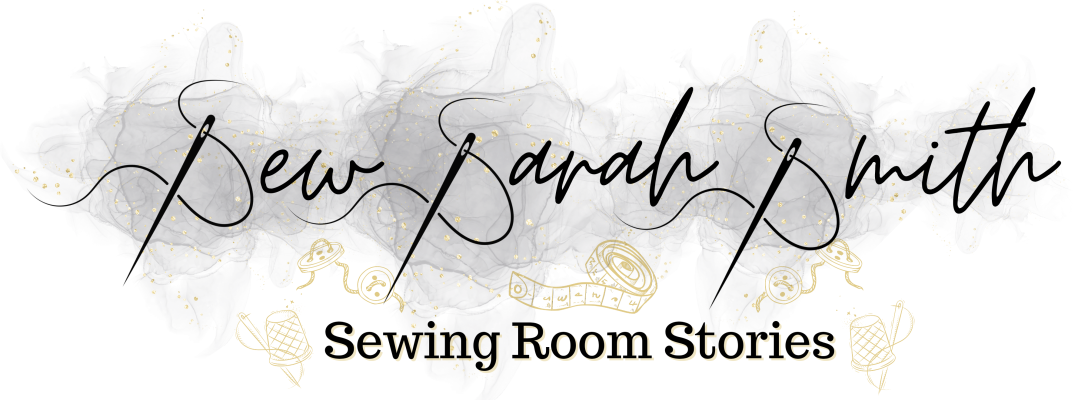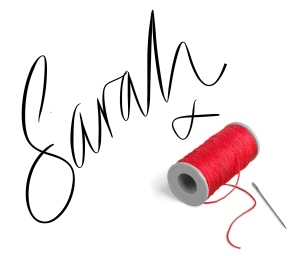Hi Sewing Peeps!
Apologies for the interruption in blogging, diary style, the making of my Deer & Doe ‘Luzerne’ Trench Coat…the trouble with blogging a make in ‘real time’ is that sometimes real life stuff unexpectedly intervenes! Long story short…my daughter spent a worrying few days in hospital. All is now well, thank goodness (and thank you to everyone who sent well wishes our way over on Instagram; that was very kind and really appreciated). I’m breathing easy again (just with more grey hair than before!), so it’s back to documenting sewing this thing!
Having previously cut the coat out and interfaced the relevant pieces, I salvaged a decent sized scrap to practice doing a bound buttonhole following the method given in Deer & Doe’s accompanying blog tutorial. I had some very good advice given on my last post when it came to the bound buttonholes from two of my favourite fellow bloggers – Firstly, Lynne (of Ozzy Blackbeard) highly recommended checking out Karen of ‘Did You Make That’ Bound Buttonhole e-Book (which is currently unavailable whilst being reformatted. Karen has very kindly offered to send me a copy of the original … but I ploughed on before having the benefit of her skill and tips!) And both Lynne and KS Sews (Dressmaking Debacles) recommended simply doing a machine buttonhole in the facings, which is definitely worth considering next time. But as a starter, I wanted to crack on and give them a go as drafted.
I found the ‘letterbox’ shaped welt pieces worked fine, except for the fact that … stitching and pivoting seems to create a tiny pucker in each corner which took some pressing to iron out. I was happy enough with this, my test one, though …

…so I decided to crack on and create the buttonholes in the left and right bodice and skirt pieces, as well as the ‘windows’ on the facings. All was going swimmingly until I realised I clearly don’t know my right from left and had accidentally created two buttonholes on the left bodice whereas you only need the one on that side. Thankfully I had enough fabric left over to re-cut that piece, otherwise I might have had a minor meltdown! Whilst rectifying my mistake, I was grinding my teeth and cursing under my breath; still, I told myself, having sidestepped this one near-disaster, now all else will be tickety-boo. Let’s hope so huh!
But yeah, don’t ‘do a Sarah’; it’s worth clearly labelling your ‘left’ and ‘right’ on all relevant pattern pieces from the off, especially the facings (which should mirror the outer shell).
And then, hurray, that happy moment when you start stitching pieces together and the garment begins to take shape! The next few stages – stitching centre front to side front, centre back to each side back (then binding and topstitching those seams); attaching the back yoke, constructing the skirt pleats and welted pockets all came together very quickly. I love watching the pile of cut pieces slowly decrease whilst the garment itself grows bigger and bigger…do you know what I mean!?
Deer & Does’ instructions don’t specifically cover the seam binding; you’re just instructed when to do it. I did contemplate whipping out my beloved binding foot but decided against it a) mainly because I’m lazy and can’t be fussed changing feet more than is absolutely necessary and b) I figured I’d have more control binding the curved areas (such as the pocket seams) doing them the traditional way.

The way I handled it was to pin the bias right sides together with the seam and with raw edges even, (pinning first to the seam side that will lay to the inside once finished and pressed). I stitch at the first crease of the bias (approximately 3/8”) and then trim the seam, notching if necessary. I then fold over the bias to enclose the seam, ensuring it covers the previous line of stitching, and sew down in place. This gave me a nice wide facing of visible bias on the right side of the pressed seam, which I think gives a very neat and pretty finish!

And then I downed tools for the day, happy to have made good progress and, for now, only one mess up!
The Next Day…
I didn’t get as much done the following day as I had other stuff to do but I just couldn’t leave it be completely; I mean I really really wanted to piece together the bodice and skirt shell so it started to look like a coat!
So, in the early hours when other, more sensible, people were still in bed, I sewed each front bodice to its corresponding skirt front (thankful they’re now clearly labelled ‘left’ and ‘right’, since I’m in a hurry and even more likely to mess up!) I bind these seams then do the same for the back. It’s worth noting here, when pinning together, that the princess seams in the bodice line up with the front skirt pocket and the back bodice seams line up with the skirt pleats. I used my fork pins, hand cranking over them, to make sure they absolutely aligned.
I did ponder the irony of stitching a coat in this heat, it might be early morning but it’s already muggy; I’m rushing and I’ve literally got sweat dripping down my face! It’s not a pretty sight!
Then it’s on to stitching the side and shoulder seams and suddenly something definitely identifiable as a coat takes shape! I don’t have time to bind the side seams or topstitch the waist seam but at least I have something to hang and admire on my dummy! So far so good!
Right, off to do t’other stuff.
Catch you on the flip side? X
Sewcialise with me on Instagram here




[…] (If you’re looking for a tutorial on Bound Buttonholes; I have a separate post on those HERE). […]
LikeLike
[…] Bound Buttonholes and Bias Binding, here […]
LikeLike
Ooo! This is looking brilliant, and I love your bias tape. Glad your daughter is feeling better too!
LikeLike
Wow, you really make a trench coat! Sewing a trench seems to me as one of the most difficult sewing projects ever! I’m looking forward to the result.
LikeLike
“I love watching the pile of cut pieces slowly decrease whilst the garment itself grows bigger and bigger…do you know what I mean!?” Yes! This is totally my favourite thing to notice when I’m sewing something together – probably because the cut pieces are taking up too much room on my desk/dining room table/living room floor… Good to hear your daughter is OK and on the mend.
LikeLike
Looking good hun! So glad to hear little ‘un is doing ok now xxx
LikeLike